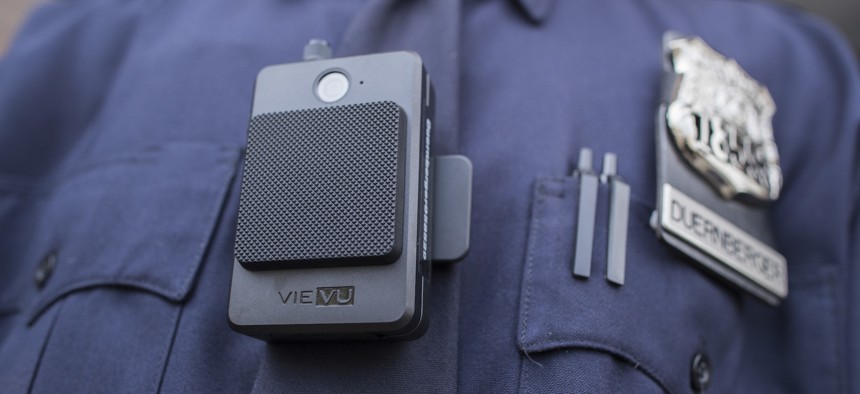Updated Body Camera Policy Scorecard Shows Very Little Progress Being Made

A police officer wears a newly issued body camera outside the 34th precinct, Thursday, April 27, 2017, in New York. Mary Altaffer / AP File Photo
At least seven departments saw their scores decline from last year.
In the wake of high-profile police-involved shooting and other use-of-force incidents in places like Baltimore, Charlotte and Ferguson, Missouri, an increasing number of departments have begun outfitting their officers with body-worn cameras. Despite the deployment of this law enforcement technology, can these cameras really promote greater transparency and accountability on the part of officers and departments?
The answer to that question, some argue, is determined by the policies that police departments put in place to guide this technology.
But, according to the Washington, D.C.-based Leadership Conference on Civil and Human Rights and Upturn, a technology-driven law and policy consulting firm, the efficacy of the rules that govern the use of the equipment vary widely across jurisdictions. And as a result, the technology doesn’t necessarily deliver on the promise of greater police oversight.
A newly updated scorecard jointly issued Tuesday by the two groups evaluated the body-worn camera policies of 75 police departments based on eight criteria.
Does the police department:
- Make its policy publicly and readily available?
- Limit officer discretion on when to record?
- Address personal privacy concerns?
- Prohibit officers from viewing the footage before they file a report?
- Limit retention of footage?
- Protect footage against tampering and misuse?
- Make footage available to individuals filing complaints?
- Limit the use of biometric technologies like facial recognition?
Overall, the results of this analysis did not produce good news.
The scorecard found that of the departments studied, only four allow people who are filing police misconduct complaints to view all the relevant footage. Only seven of the departments have written policies that limit the use of facial recognition or other biometric technologies, and only 11 jurisdictions mandate that unflagged, unneeded footage must be deleted within six months of its recording.
The scorecard’s authors also note that there has been very little progress made from last year’s analysis. Over half of those departments did not make any policy changes at all. Eighteen departments made policy changes, but in very minor ways. And, as many as seven departments—Chicago; Cleveland; Fairfax County, Virginia; Fayetteville, North Carolina; Houston; Minneapolis; and Rochester, New York—actually saw their scores decline.
The one bright spot in the report came out of Baltimore. That department’s policy score improved over 4 of the 8 indicators.
Read the 2017 scorecard in full to see where the policies of various localities stack up.
Quinn Libson is a Staff Correspondent for Government Executive’s Route Fifty and based in Washington, D.C.
NEXT STORY: Funding, fiber, cyber: A recipe for smarter cities






